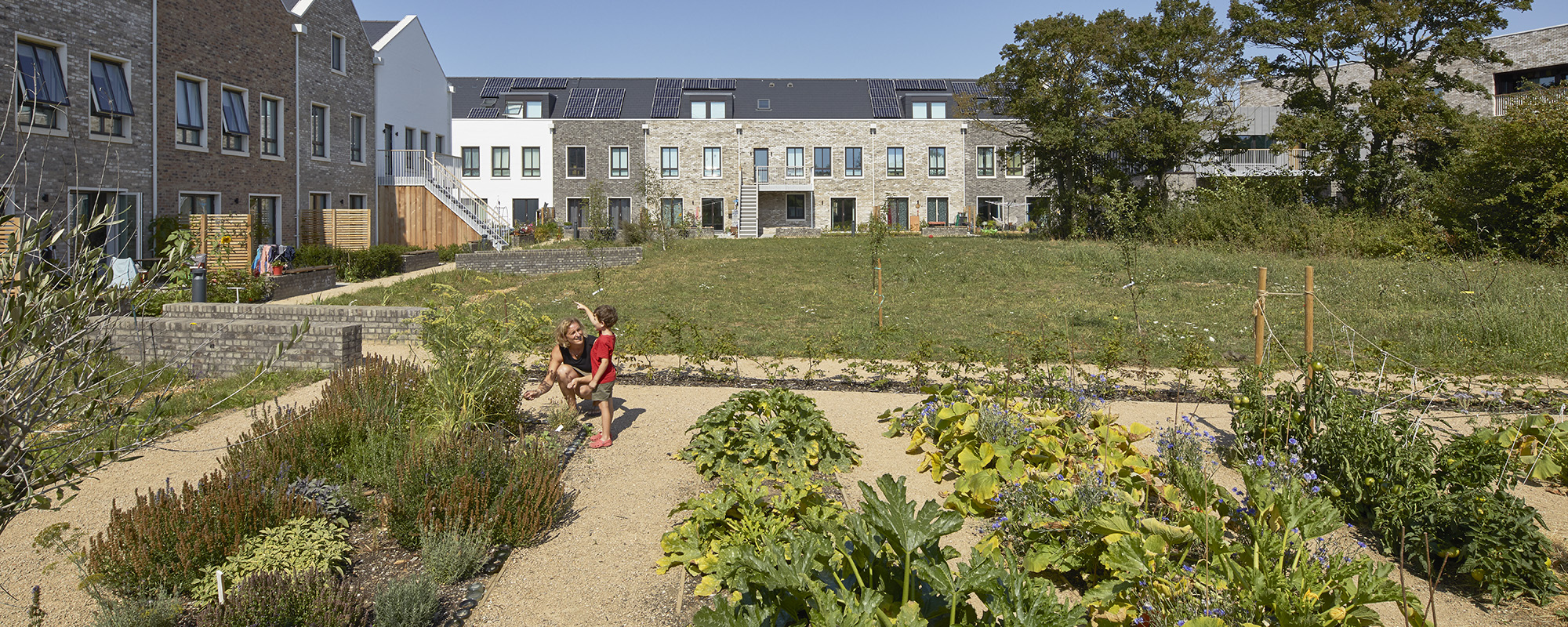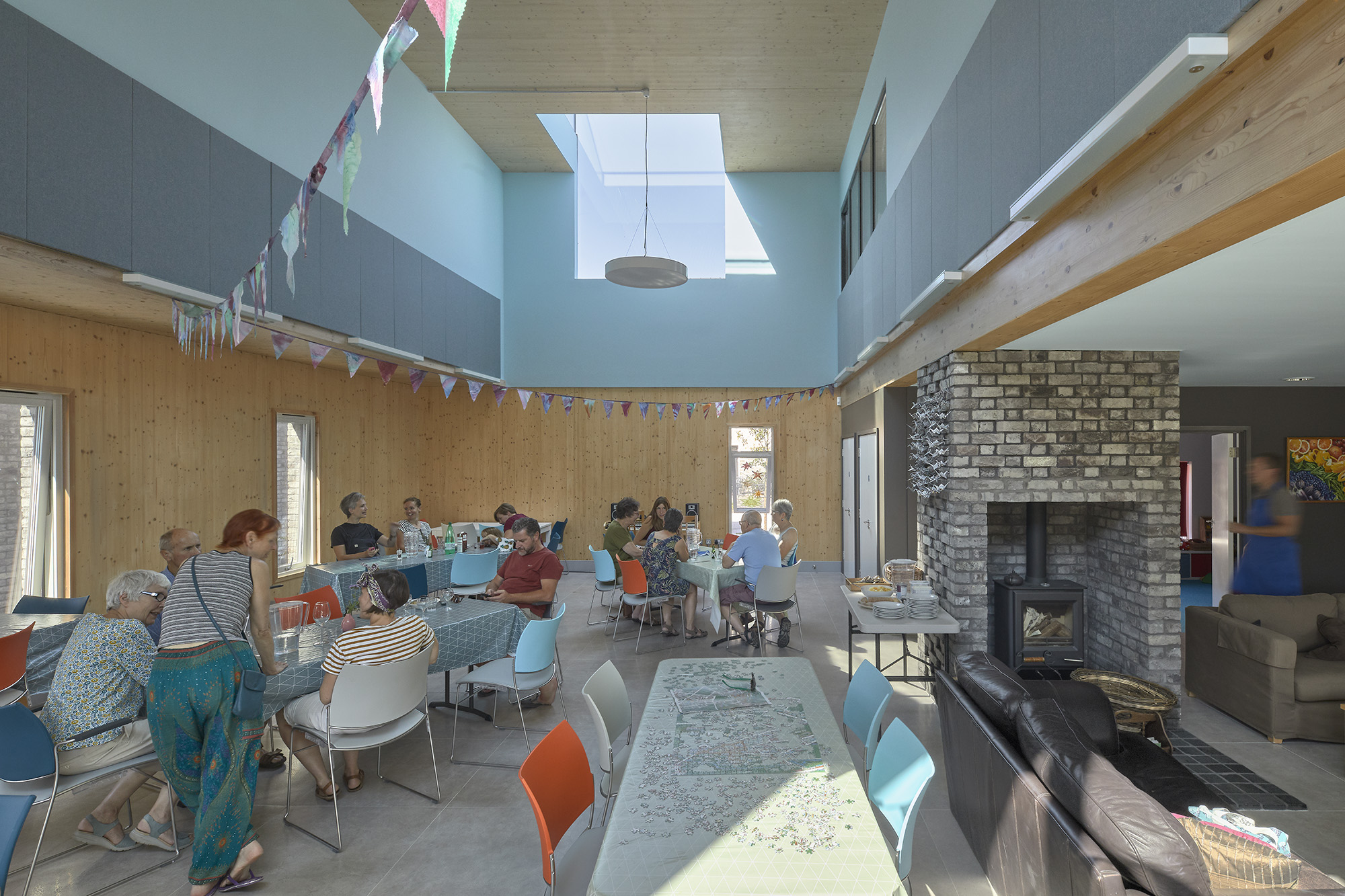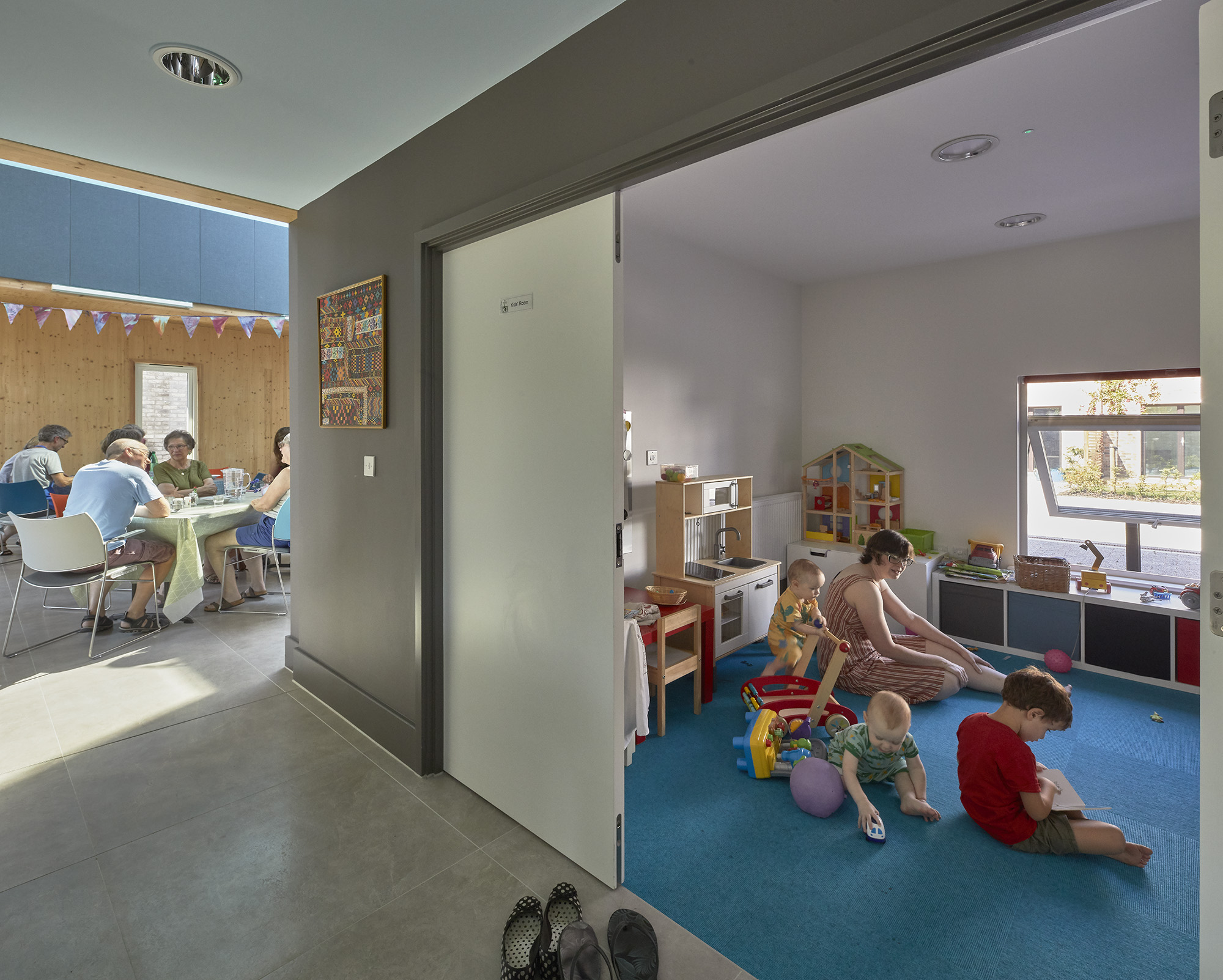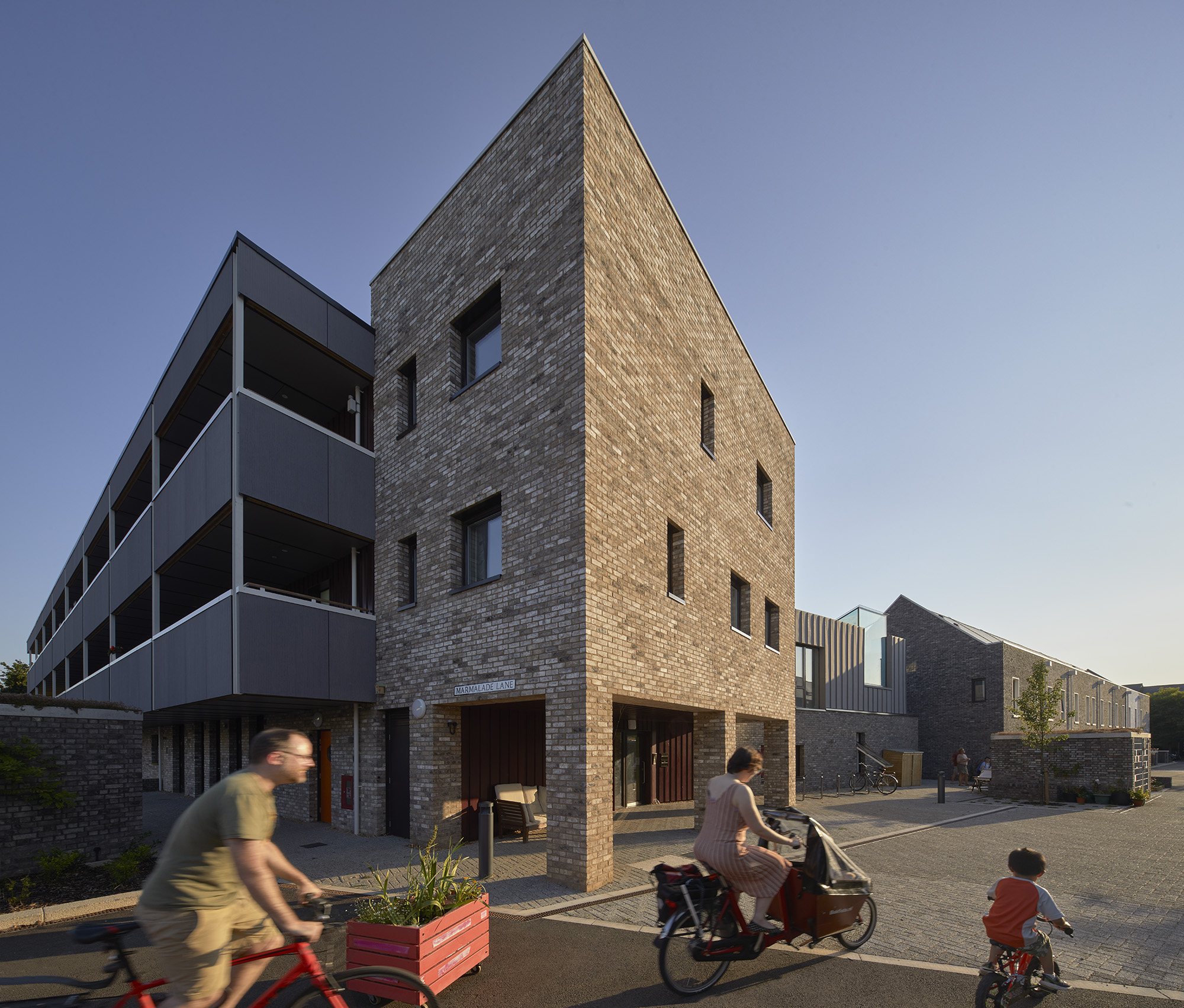Get updates from The Developer straight to your inbox Yes, please!
The miracle of Marmalade Lane
Cambridge’s cohousing project has established a resilient, intergenerational community. How did they do it – and can it be replicated? Laura Mark reports. Photography by David Christian

Laura Mark is an award-winning architecture critic, curator and filmmaker. Laura is currently undertaking a PhD at Newcastle University
......Just 15 minutes’ cycle from Cambridge city centre lies Marmalade Lane, an urban idyll of 42 brick-clad homes with car-free streets, where children play football and draw chalk murals. It stands in stark contrast to the surrounding suburban cul-de-sacs of the Orchard Park Estate, designed 10 years ago to be aspirational but now dubbed ‘Beirut’ by residents.
Marmalade Lane is a plot left over from that previous housing development and wouldn’t have happened if it hadn’t been for the recession. In 2008, the developers for the site walked away leaving a plot (known as K1) which Cambridge Council struggled to find anyone else to develop. It decided to allocate the plot to cohousing and was successful in gaining funding from the Homes and Communities Agency (now Homes England) to draw up a brief with the K1 cohousing group.
But for this to work, they needed the equity from a development partner so the residents wouldn’t spend all their money on buying the land – the biggest barrier for cohousing groups is always land cost and availability.
So in 2014, armed with a 60-page brief drawn up by the K1 cohousing group, the council held a two-stage developer-led competition. The winning developer would have to work with the cohousing community and local planning authority to complete the final design, and fund and deliver the development.
From a shortlist of three, the final stage was won by a team made up of relatively new developer Town, Swedish offsite timber manufacturer Trivselhus, and architecture practice Mole.
Meredith Bowles, founder of Mole, comments that this is a fairly unusual model for a cohousing scheme: “This is not the way most cohousing schemes go. This was more like a normal housing project due to the procurement.”
At the time of the developer competition, there were around 20 households who were members of the cohousing group, of which around 15 remain and have moved into the built scheme.
“I can see why some developers don’t want to know their end users. When you do you worry about them and it becomes more personal”
“Sticking to the brief rigidly became secondary as we were evolving the plans,” comments Jonny Anstead, founding director of Town. “But this could only happen after trust with the cohousing group had been developed. If it had been a more cynical developer, the brief they had already developed would have been more important.”
According to Mole, the scheme differs in some ways from that initially briefed. Cars were originally placed around the outside of the site and the scheme was a lot more inward looking, but this was reversed with the creation of the internal car-free street and by moving the common house to the centre of the plan, giving it a relationship with the garden.
They also worked to rationalise the types of homes on offer. The architects developed three different house types, which could then be configured with up to 27 different internal layouts. These are all the same depth so can be positioned anywhere along a terrace while the width can vary. This allowed residents choice and the ability to configure their own homes to their needs while keeping the costs down and allowing for offsite timber construction.
These design changes were worked out with residents over a four-month period through workshops. The cohousing group had working groups that focused on the houses, landscaping, energy use and common spaces, and they all met with the architects and developer on a regular basis and fed back to the rest of the community.
“We only met with the full group of residents a couple of times,” says Bowles. “It was brilliantly organised and they made decisions efficiently based on consensus. As there were different members in each group it felt like we met with a lot of them regularly.”
But there were some frustrations with this process.
“Once we had won the competition, the developer had committed to the cost of the scheme. It meant that the amount that could be changed was pretty limited. This was slightly frustrating,” comments Bowles. “It would have been nice to have spent more time with the residents early on.”
“I can see why some developers don’t want to know their end users. When you do you worry about them and it becomes more personal,” says Anstead. “This is a whole new way of doing it. Developers should have contact with those living in their homes and that would change the context of housing today.”
At Marmalade Lane, all residents have a share of the common house – the central space that includes a large catering kitchen, dining room, yoga studio, gym, library, laundry and guest bedrooms. Originally this space was briefed to be twice the size but during the design process they took stock of what was really needed and how it would be managed. Financial costs are shared and kept down by the expectation that residents will take part in a cleaning rota and a quarterly work day.
For it to thrive and remain open and welcoming, there has to be a blurred line between public and private
“All of our shared areas are great and we are finding ways to use them, but the more shared areas you have the more maintenance and cleaning you need to do,” comments resident Lora Brill, when asked what advice she would give to other groups planning their communal spaces.
“There is so much communal space that we use parts of it and not other parts,” she adds. “We use the lane behind our houses heavily. My son loves to play football out there. I go to yoga and pilates in the common house.”
It is this lane which seems to be one of the most popular spaces. Although the first time I visit it is a rainy, grey day there is still a child playing and there are trikes, bicycles and other toys scattered around. I’m told if you are there after school it is filled with all the kids from the housing.
The success of this lane partly lies in the overlooking aspect: on one side, front doors open directly onto it, while on the other, the houses’ back gardens adjoin the lane separated by just low walls and hedges. It will be interesting to see whether residents keep it this way or decide to let their hedges grow higher or add fences or more greenery. But the shared nature of an intentional community like this suggests that for it to thrive and remain as open and welcoming as it currently is, there has to be a blurred line between public and private.
Cohousing first became recognised in the 1970s when intentional communities, often with a social and environmental ethos, formed in Denmark. It slowly spread across Europe and now 7% of all housing in Denmark is cohousing and Germany also has a similar system called ‘baugruppen’ (meaning group build), where the council provides bridging finance and identifies sites.
“We went to Copenhagen and the Netherlands and looked at cohousing there, and the radical difference is the attitude to private space,” says Bowles.
Once the reserve of hippy-types and seen as a milder version of communes and housing co-operatives, cohousing is gaining traction. In particular, we are seeing it being targeted at older homeowners as a way to tackle the loneliness epidemic. In 2017, Saga Magazine even published an article encouraging its audience of mainly pensioners to consider the housing type.
Marmalade Lane resident Jan Chadwick and her husband decided to move to the estate after reading an article on cohousing in The Guardian: “We started to think about our situation, as 60-year-olds. With one daughter, and no desire to become dependent older parents, we saw cohousing as a potential solution to ensure we stayed interested, lively and engaged in our community, now and during our twilight years.”
But at Marmalade Lane, which houses a mixture of families with young children, retired couples and young professionals, it is the families who really feel they benefit.
“The voices of women with children doesn’t seem to get heard by the housing industry. But here it is safe,” comments resident Frances Wright. “It has become an easier place for families and young mothers with children to live as there is support.”
“It makes it much easier to parent, frankly. It means you aren’t constantly trying to entertain your children yourself”
“It makes it much easier to parent, frankly. It means you aren’t constantly trying to entertain your children yourself. There are other kids for them to play with. We hardly ever need to go to the park any more because we have so much space here,” adds Brill.
There are around 20 residents under the age of 10 who live within the scheme. Having the extra space for children to play outside in the lane, the gardens or even the common house takes the pressure off families having children crammed inside each other’s houses.
Of the residents I speak to, many have jobs with an environmental or social conscious focus, and it is easy to wonder whether the move towards these types of more shared developments is something being driven by the liberal elite.
“My interest in community housing comes from various sources, but predominantly my work for Argyle Street Housing Co-operative. Seeing it in action really made me want to live in an intentional community myself,” says resident Hannah Shields.
“My main driver has always been the children. I really feel that cohousing will be hugely beneficial to them, with increased freedom and a sense of extended family. I also think growing up in a community where tolerance, respect and compromise are practised through consensus decision-making will be a fantastic education in how to be an active member of society.
“I love the idea of our four children having so many adults beyond ourselves with whom to engage and learn from.”
Brill adds: “You go into jobs related to sustainability and social justice because you care about those things. Here you can have a cohesiveness between your work life and your home life.”
Marmalade Lane isn’t a one-off. It is among 20 schemes in existence in the UK, including the well-known projects Lancaster Cohousing on the outskirts of Preston, Low Impact Living Affordable Community (LILAC) in Leeds, and the Older Women’s Cohousing community in north London.
But it is one of the lucky schemes that did get off the ground. Cambridge K1 Cohousing originally formed in 2000 but struggled to find a plot and many projects are getting lost during this process of finding land. According to the UK Cohousing Network, there are currently 60 groups waiting to get started.
“Making land available for groups that are motivated would mean that more cohousing would happen. It is so hard to get land and to start the development process. Groups can spend a decade trying to create cohousing and that’s really such a waste of valuable energy and time. It could happen so much faster if land was made available,” adds Brill.
Town is now working with 12 other cohousing groups where it will take forward what it has learned on this scheme
“The barriers to cohousing are usually wholly financial,” says Bowles. “People can overcome the organisational difficulties but the first hurdle is always land.”
Bowles adds: “It needs local authority intervention. They could intervene through the planning system or by making land available.”
For the residents of Marmalade Lane it has taken 20 years to get to this point. With prices ranging from £195,000 for a one-bedroom apartment to £535,000 for a five-bedroom house and with no requirement for building any affordable homes, this isn’t housing which is open to all and it isn’t going to solve the housing crisis. But it does provide an example of what can be done when a council releases land and a community gathers together and sticks with the process.
In Cambridge this type of community-led development was a last resort, a decision made by a fairly forward-thinking council when it knew it wasn’t going to be able to develop the site in the usual way. Town, the developer, is now working with 12 other cohousing groups where it will take forward what it has learned on this scheme. So, for other cities this has the potential to really challenge our traditional methods of bringing forward housing. But it will only work with planning and land-system changes.
Let’s take a lesson from Germany’s baugruppen and perhaps then streets where children play, common spaces with shared dinners, and truly intergenerational communities will become a positive outcome of the housing crisis.
Laura Mark is an award-winning architecture critic, curator and filmmaker. She is currently the keeper at Walmer Yard – a set of four houses in Notting Hill designed by Peter Salter – where she runs the Baylight Foundation, a charitable organisation with the aim of increasing the public’s understanding of what architecture can do
Sign up to our newsletter
Get updates from The Developer straight to your inbox
Thanks to our organisation members
© Festival of Place - Tweak Ltd., 124 City Road, London, EC1V 2NX. Tel: 020 3326 7238





